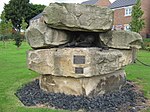NETPark
NETPark, or the North East Technology Park, is a science park in Sedgefield, Durham. It is owned by Durham County Council and run by Business Durham, the business support service of the council, with strategic partners Centre for Process Innovation (CPI) and Durham University.NETPark hosts three national catapult centres: CPI was a founding partner of the High Value Manufacturing Catapult in 2011 and are joined by the North East Centre of Excellence for Satellite Applications and the Space Enterprise Lab NETPark, part of the Satellite Applications Catapult, and the Compound Semiconductor Applications Catapult North East. CPI also manages three national innovation centres at NETPark: the National Formulation Centre, the National Printable Electronics Centre and the National Healthcare Photonics Centre. It is also home to Orbit, Durham University's enterprise zone, and the university's Centre for Advanced Instrumentation. NETPark was opened in 2004 by the local Member of Parliament for Sedgefield and Prime Minister of the United Kingdom, Tony Blair.
Excerpt from the Wikipedia article NETPark (License: CC BY-SA 3.0, Authors).NETPark
Thomas Wright Way,
Geographical coordinates (GPS) Address Nearby Places Show on map
Geographical coordinates (GPS)
| Latitude | Longitude |
|---|---|
| N 54.670277777778 ° | E -1.4508333333333 ° |
Address
NETPark Incubator
Thomas Wright Way
TS21 3FF
England, United Kingdom
Open on Google Maps




